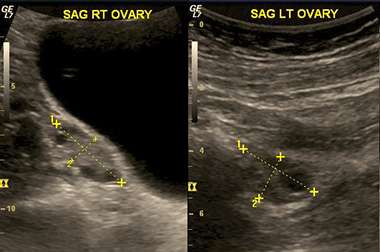Left and right side ultrasounds of ovaries with developing follicles.
(Medical Xpress)—University at Albany epidemiologist Michael Bloom and three fellow researchers have released a study on how the "good cholesterol" may play a role within the ovarian follicle in pre-programming an egg for successful pregnancy or failure.
The report, published online in the journal Fertility and Sterility, studies variability in the components of high-density lipoprotein (HDL) between follicles within a woman and how this variation relates to differences in levels between different women. Human 'follicular fluid' that bathes an immature egg cell (oocyte) is a complex mixture of lipids, proteins, hormone, micronutrients and other molecules. HDL is the only lipoprotein identified in this follicular fluid.
Along with UAlbany Ph.D. candidate Keewan Kim, reproductive endocrinologist Victor Y. Fujimoto of the University of California, San Francisco (UCSF), and University at Buffalo (UB) biochemist Richard W. Browne, Bloom collected the follicular fluid from two ovarian follicles in each of 171 women undergoing in vitro fertilization for treatment of infertility at UCSF. At UB laboratories, levels of various HDL-particle components were measured.
"Using statistical analysis we found that the variation in HDL-particle components within a woman was frequently greater than the variation between different women, suggesting that each ovarian follicle was a chemically and metabolically active 'mini-organ'" said Bloom, a member of the School of Public Health's Department of Environmental Health Sciences. "In other words, each follicle appeared to actively create a unique 'micro-environment' for the developing egg."
Furthermore, the researchers found that the extent of this variability was different according to age, body mass, cigarette smoking, race and infertility diagnosis—factors that predict the likelihood for a woman to deliver a live baby following in vitro fertilization (IVF). Given the societal dilemma of reproductive choice with advanced maternal age as well as the increasing evidence of the influence of environmental exposures upon reproductive physiology, greater understanding of the role that the HDL-particle plays in the health of the human ovarian follicle and the oocyte may be critically important.
"To our knowledge, this is the first indication of the importance of follicular fluid HDL particle variability within a woman in assisted human reproduction, rather than just differences between women," said Bloom.
"Understanding what makes an egg healthy or not is critical to improving the opportunity for women desiring to conceive," said Fujimoto, who directs UCSF's Vitro Fertilization Program. With the study's results suggesting that the metabolic activity of the ovarian follicle influences oocyte competence, it may offer an opportunity for clinical intervention in the future, to improve the live birth rate following IVF.
According to Bloom, the study has implications for the design of future analysis examining follicular fluid parameters as predictive markers of IVF success or failure. The next step will be to examine the impact of this variability on oocyte fertilization, embryo development, pregnancy and live birth following IVF among the women in the study.
The group's work is part of a larger study supported by the U.S. National Institute of Aging/National Institutes of Health, designed to better define the physiology of human ovarian follicle metabolism, and the manner in which cholesterol influences the developmental potential of the human oocyte and embryo.
Journal information: Fertility and Sterility
Provided by University at Albany



















